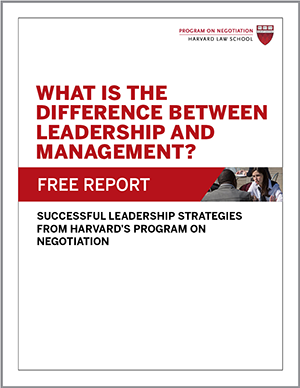
When choosing our personal leadership style, we have many different models to choose from, including participative leadership, charismatic leadership, directive leadership, authoritarian leadership, paternalistic leadership, and servant leadership theory. Each leadership theory promotes a particular approach to running organizations, from involving employees fully in decisions to handing down directives. By contrast, the contingency theory of leadership argues that rather than adapting their style to the organization, leaders should fill roles based on how well they “match” the situation. Let’s take a closer look at the contingency theory of leadership.
What Is the Contingency Theory of Leadership?
The contingency theory of leadership, which emerged from numerous scholars in the 1960s, is rooted in the belief that earlier management theories had neglected the influence of situational factors, or contingencies, on organizations. Examples of contingencies include the state of the economy, the availability of trained labor, the organization’s culture, government policies and laws, the effects of climate change, and other factors. In a 1995 paper, Roya Ayman, Martin M. Chemers, and Fred Fiedler write that two main factors contribute to effective leadership: (1) attributes of the leader and (2) the degree to which the situation gives the leader power, control, and influence.
In particular, the contingency theory of leadership distinguishes between leaders who are task oriented vs. relationship oriented. Task-oriented leaders focus primarily on ensuring that the tasks needed to meet particular goals are completed well and on time. These leaders tend to have a more autocratic, authoritarian, or directive leadership style. They also tend to manage projects effectively, but they can stifle creativity and leave employees feeling uninspired. Relationship-oriented leaders, by contrast, focus on building strong, lasting relationships with their employees and prioritize a healthy work culture. These leaders tend to have highly motivated, engaged employees, but tasks may run late and over budget.
Rather than valuing one of these leadership styles over the other, the contingency theory of leadership asserts that leaders with different styles will succeed based on the level of control they have over the situation—known as situational control.
Situational control has three components, according to Ayman and colleagues:
- Leader-member relations: the amount of cohesiveness in the work team and the team’s support for the leader. “Leader-member relations is the most important aspect of the situation,” they write, “because if the leader lacks group support, energy is diverted to controlling the group rather than toward planning, problem-solving, and productivity.”
- Task structure: the clarity and certainty in tasks, goals, and procedures that allow leaders to confidently guide group activities. The more predictable and certain a task is, the greater the leader’s sense of situational control.
- Position power: the amount of administrative authority that an organization grants a leader. Like task structure, position power contributes to a leader’s perceived situational control.
Task-oriented leaders will be more successful in situations where they have high or low control, and leaders who are relationship oriented will be more successful in situations where they have moderate control, write Ayman and colleagues.
What Contingencies Matter?
In a chapter on the contingency theory of leadership in the Handbook of Leadership Theory and Practice, Jay Lorsch posits that leaders’ personalities and style are shaped at a young age and difficult to change. As such, he argues, “the most important benefit of a modern contingency theory would be to enable individual leaders and those who select them to understand clearly what qualities leaders will need to succeed in different situations.” That is, leaders can be chosen to match the existing demands of the organization.
Lorsch notes several contingencies that affect the ideal type of leader for an organization:
- Followers’ expectations of their leaders, such as the degree to which leaders are expected to be involved in decisions and provide direction; their level of technical or professional competence; and the degree to which they bond with followers.
- Organizational complexity, including the size of the organization, which affects many factors, including the levers of power and influence available to leaders and the relative difficulty of conveying one’s message, competence, and charisma.
- International differences. Operating in a single location makes it easier for leaders to be known by their followers and to project their competence than operating in multiple, far-flung locations. Some leaders may excel at cross-cultural communication, while others will be challenged by it.
- The organization’s tasks. The work of organizations tends to range from routine and repetitive (such as manufacturing established products) to innovative and novel (such as launching untested products). When tasks are certain and straightforward, a more directive leadership style is more effective; when tasks are uncertain, a more participative leadership style would be more suitable.
In sum, the contingency theory of leadership emphasizes the value of ensuring the right “fit” among leaders, employees, and the organization as a whole, rather than assuming that leaders will be able to adapt their skills and tendencies to the demands of the situation.
What pros and cons do you see in the contingency theory of leadership when applied to the daily life of organizations?




